Unit 3 How do you get to school?基础知识梳理课件(共有PPT15张)
文档属性
| 名称 | Unit 3 How do you get to school?基础知识梳理课件(共有PPT15张) | 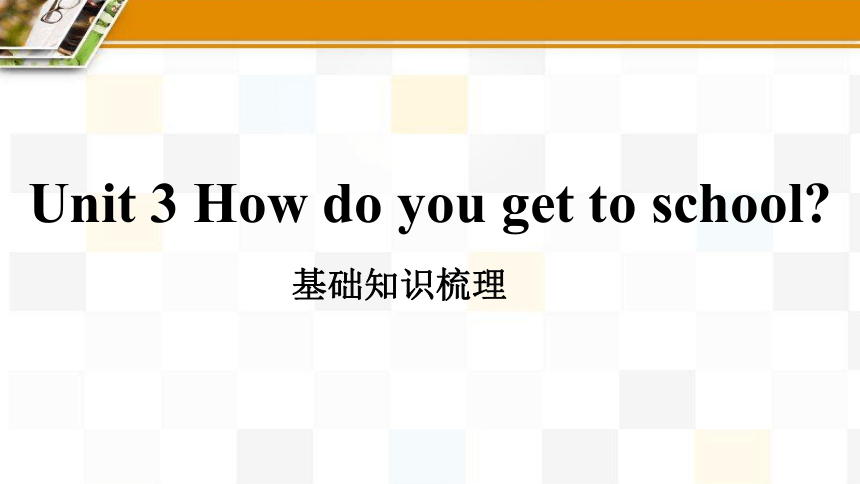 | |
| 格式 | zip | ||
| 文件大小 | 132.3KB | ||
| 资源类型 | 教案 | ||
| 版本资源 | 人教新目标(Go for it)版 | ||
| 科目 | 英语 | ||
| 更新时间 | 2022-03-12 09:30:08 | ||
图片预览

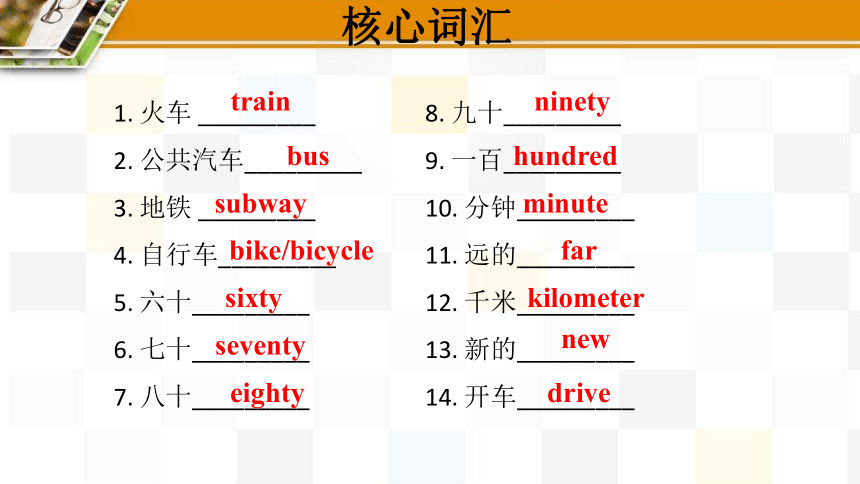
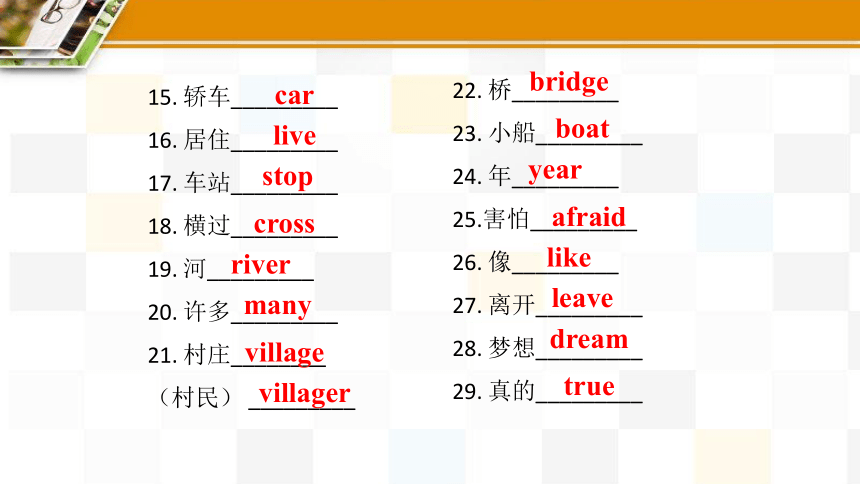
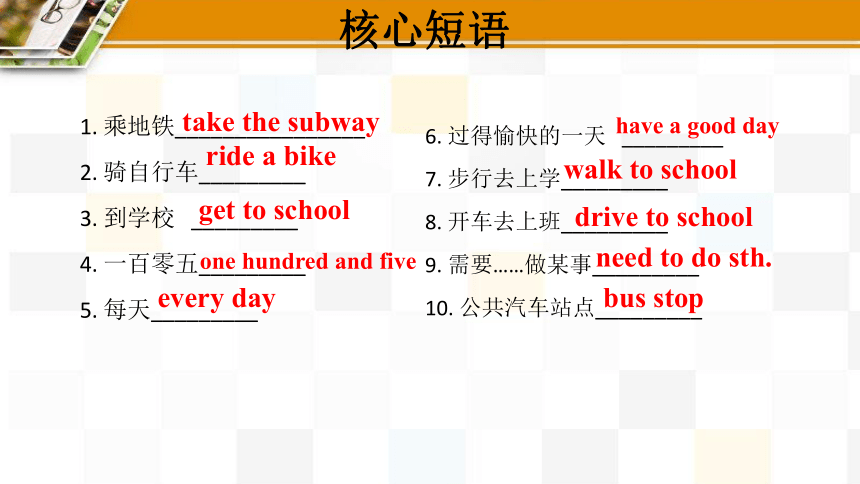
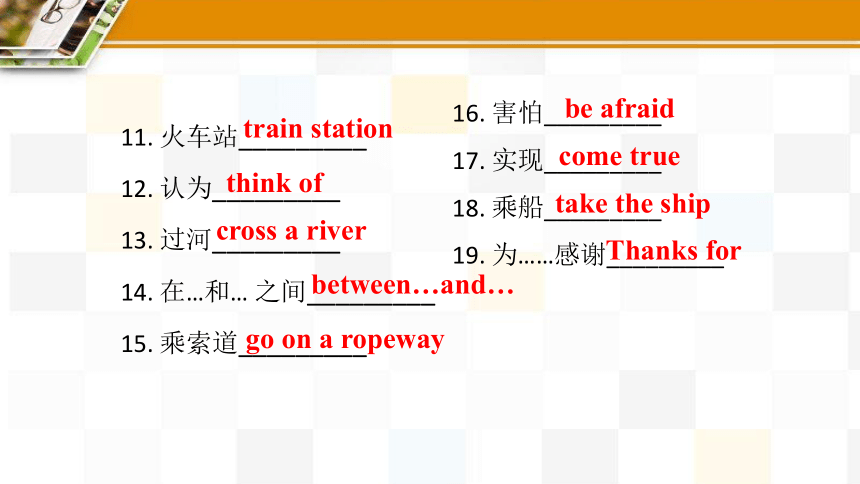
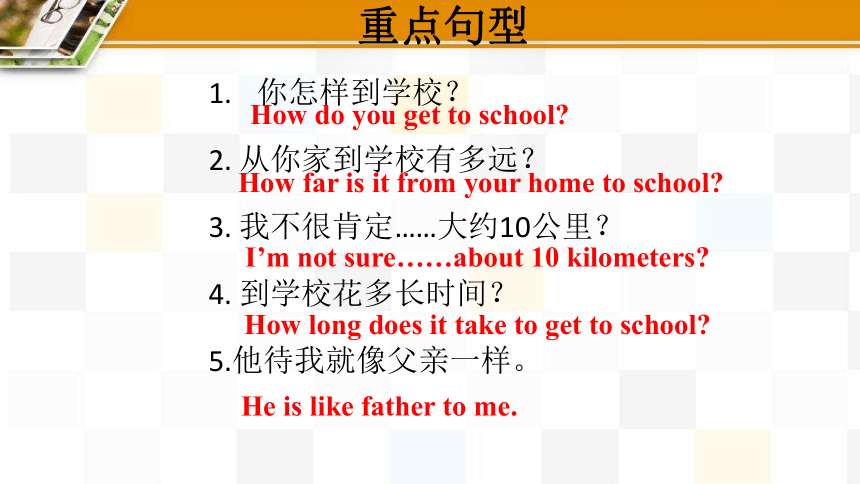
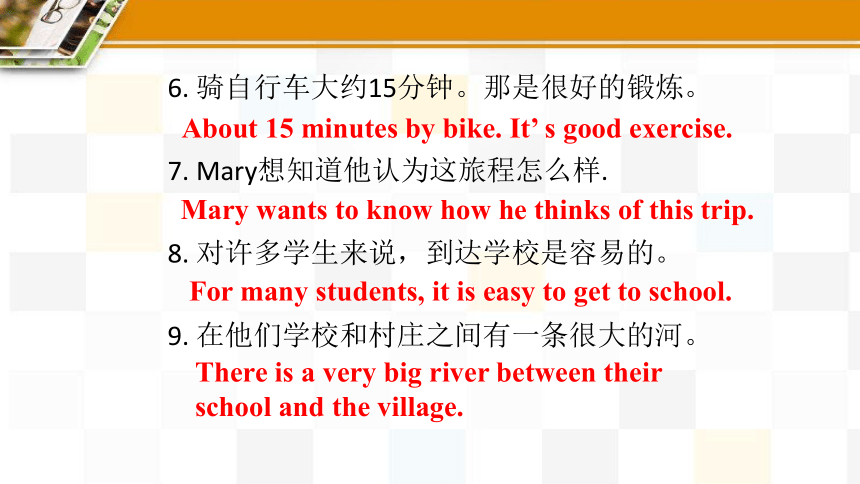
文档简介
(共15张PPT)
Unit 3 How do you get to school
基础知识梳理
核心词汇
1. 火车 _________
2. 公共汽车_________
3. 地铁 _________
4. 自行车_________
5. 六十_________
6. 七十_________
7. 八十_________
8. 九十_________
9. 一百_________
10. 分钟_________
11. 远的_________
12. 千米_________
13. 新的_________
14. 开车_________
train
bus
subway
minute
sixty
seventy
eighty
ninety
hundred
far
bike/bicycle
kilometer
new
drive
15. 轿车_________
16. 居住_________
17. 车站_________
18. 横过_________
19. 河_________
20. 许多_________
21. 村庄________
(村民) _________
22. 桥_________
23. 小船_________
24. 年_________
25.害怕_________
26. 像_________
27. 离开_________
28. 梦想_________
29. 真的_________
car
live
stop
cross
river
many
village
villager
bridge
boat
year
afraid
like
leave
dream
true
核心短语
1. 乘地铁________________
2. 骑自行车_________
3. 到学校 _________
4. 一百零五_________
5. 每天_________
6. 过得愉快的一天 _________
7. 步行去上学_________
8. 开车去上班_________
9. 需要……做某事_________
10. 公共汽车站点_________
take the subway
ride a bike
get to school
one hundred and five
every day
have a good day
walk to school
drive to school
need to do sth.
bus stop
11. 火车站_________
12. 认为_________
13. 过河_________
14. 在…和… 之间_________
15. 乘索道_________
16. 害怕_________
17. 实现_________
18. 乘船_________
19. 为……感谢_________
train station
think of
cross a river
between…and…
go on a ropeway
be afraid
come true
take the ship
Thanks for
重点句型
你怎样到学校?
2. 从你家到学校有多远?
3. 我不很肯定……大约10公里?
4. 到学校花多长时间?
5.他待我就像父亲一样。
How do you get to school
How far is it from your home to school
I’m not sure……about 10 kilometers
How long does it take to get to school
He is like father to me.
6. 骑自行车大约15分钟。那是很好的锻炼。
7. Mary想知道他认为这旅程怎么样.
8. 对许多学生来说,到达学校是容易的。
9. 在他们学校和村庄之间有一条很大的河。
About 15 minutes by bike. It’ s good exercise.
Mary wants to know how he thinks of this trip.
For many students, it is easy to get to school.
There is a very big river between their school and the village.
10. (河上)没桥,而且河水湍急,不宜小船摆渡。
11. 亮亮,一个11岁男孩,每天过河上学。
12. 拥有一座桥是他们的梦想。
13. 谢谢你的上一封电子邮件。
There is no bridge and the river runs too quickly for boats.
Liangliang, a 11-year-old boy, crosses the river
every school day.
It is her dream to have a bridge.
Thank you for your last e-mail.
知识点梳理
关于出行方式的提问和回答
提问:How+do/does+主语+get to+地点?
常用回答如下:
借助于“by+交通工具” By bike/car/train/bus/subway…
借助于take,ride,drive构成动词短语 take+a/the+bus/train/plane
drive+a/the/one’s+car
Ride+a/the/one’s+bike/bicycle
借助于on、in on foot/in a car
2. It takes sb.some time to do sth.句式
表示“某人花费多长时间做某事”,take表示“花费(时间)”
It take me 20 minutes to walk to the zoo.我要花20分钟走到动物园。
例:Mount Tai is not far away from here, but it still take us a few hours _____ there by bike.
A. getting B. to get C. got D. get
B
3. It’s +adj.+for sb. to do sth.句式
意为“对某人来说做某事怎么样”,for sb.有时省略。
It’s very important for us to study English well.
对我们来说,学好英语很重要。
例:It is necessary ____ people to have food and water every day.
A. of B. for C. with
B
4. many 和much 的区别
例:There are _____ apples on the tree.
A. much B. many C. lot of D. a lot
many 修饰可数名词复数。many books, many apples
much 修饰不可数名词。much money, much water
注意: a lot of, lots of 可以修饰可数名词(相当于many),也可修饰不可数名词(相当于much)
B
5.
between与among的区别
between 指“两者之间”, 后接三者或三者以上的事物或人时, 是把这些事物或人分别看待, 指每两者之间
among 为“在中间”, 用于三者或三者以上的中间
6. 与afraid相关的用法
be afraid of doing sth. /sth. 担心做某事(害怕某物) 后面接动名词、名词或代词, 表示心理活动
be afraid to do sth. 害怕去做某事 后接动词原形, 表示行为、动作
be afraid that. . . 恐怕, 担心 后接that从句, 表示对将要发生事情的担忧
(I’m)afraid so(not) 恐怕如此(不是) 用于回答别人的提问
Thank you
Unit 3 How do you get to school
基础知识梳理
核心词汇
1. 火车 _________
2. 公共汽车_________
3. 地铁 _________
4. 自行车_________
5. 六十_________
6. 七十_________
7. 八十_________
8. 九十_________
9. 一百_________
10. 分钟_________
11. 远的_________
12. 千米_________
13. 新的_________
14. 开车_________
train
bus
subway
minute
sixty
seventy
eighty
ninety
hundred
far
bike/bicycle
kilometer
new
drive
15. 轿车_________
16. 居住_________
17. 车站_________
18. 横过_________
19. 河_________
20. 许多_________
21. 村庄________
(村民) _________
22. 桥_________
23. 小船_________
24. 年_________
25.害怕_________
26. 像_________
27. 离开_________
28. 梦想_________
29. 真的_________
car
live
stop
cross
river
many
village
villager
bridge
boat
year
afraid
like
leave
dream
true
核心短语
1. 乘地铁________________
2. 骑自行车_________
3. 到学校 _________
4. 一百零五_________
5. 每天_________
6. 过得愉快的一天 _________
7. 步行去上学_________
8. 开车去上班_________
9. 需要……做某事_________
10. 公共汽车站点_________
take the subway
ride a bike
get to school
one hundred and five
every day
have a good day
walk to school
drive to school
need to do sth.
bus stop
11. 火车站_________
12. 认为_________
13. 过河_________
14. 在…和… 之间_________
15. 乘索道_________
16. 害怕_________
17. 实现_________
18. 乘船_________
19. 为……感谢_________
train station
think of
cross a river
between…and…
go on a ropeway
be afraid
come true
take the ship
Thanks for
重点句型
你怎样到学校?
2. 从你家到学校有多远?
3. 我不很肯定……大约10公里?
4. 到学校花多长时间?
5.他待我就像父亲一样。
How do you get to school
How far is it from your home to school
I’m not sure……about 10 kilometers
How long does it take to get to school
He is like father to me.
6. 骑自行车大约15分钟。那是很好的锻炼。
7. Mary想知道他认为这旅程怎么样.
8. 对许多学生来说,到达学校是容易的。
9. 在他们学校和村庄之间有一条很大的河。
About 15 minutes by bike. It’ s good exercise.
Mary wants to know how he thinks of this trip.
For many students, it is easy to get to school.
There is a very big river between their school and the village.
10. (河上)没桥,而且河水湍急,不宜小船摆渡。
11. 亮亮,一个11岁男孩,每天过河上学。
12. 拥有一座桥是他们的梦想。
13. 谢谢你的上一封电子邮件。
There is no bridge and the river runs too quickly for boats.
Liangliang, a 11-year-old boy, crosses the river
every school day.
It is her dream to have a bridge.
Thank you for your last e-mail.
知识点梳理
关于出行方式的提问和回答
提问:How+do/does+主语+get to+地点?
常用回答如下:
借助于“by+交通工具” By bike/car/train/bus/subway…
借助于take,ride,drive构成动词短语 take+a/the+bus/train/plane
drive+a/the/one’s+car
Ride+a/the/one’s+bike/bicycle
借助于on、in on foot/in a car
2. It takes sb.some time to do sth.句式
表示“某人花费多长时间做某事”,take表示“花费(时间)”
It take me 20 minutes to walk to the zoo.我要花20分钟走到动物园。
例:Mount Tai is not far away from here, but it still take us a few hours _____ there by bike.
A. getting B. to get C. got D. get
B
3. It’s +adj.+for sb. to do sth.句式
意为“对某人来说做某事怎么样”,for sb.有时省略。
It’s very important for us to study English well.
对我们来说,学好英语很重要。
例:It is necessary ____ people to have food and water every day.
A. of B. for C. with
B
4. many 和much 的区别
例:There are _____ apples on the tree.
A. much B. many C. lot of D. a lot
many 修饰可数名词复数。many books, many apples
much 修饰不可数名词。much money, much water
注意: a lot of, lots of 可以修饰可数名词(相当于many),也可修饰不可数名词(相当于much)
B
5.
between与among的区别
between 指“两者之间”, 后接三者或三者以上的事物或人时, 是把这些事物或人分别看待, 指每两者之间
among 为“在中间”, 用于三者或三者以上的中间
6. 与afraid相关的用法
be afraid of doing sth. /sth. 担心做某事(害怕某物) 后面接动名词、名词或代词, 表示心理活动
be afraid to do sth. 害怕去做某事 后接动词原形, 表示行为、动作
be afraid that. . . 恐怕, 担心 后接that从句, 表示对将要发生事情的担忧
(I’m)afraid so(not) 恐怕如此(不是) 用于回答别人的提问
Thank you
同课章节目录
- Unit 1 Can you play the guitar?
- Section A
- Section B
- Unit 2 What time do you go to school?
- Section A
- Section B
- Unit 3 How do you get to school?
- Section A
- Section B
- Unit 4 Don't eat in class.
- Section A
- Section B
- Unit 5 Why do you like pandas?
- Section A
- Section B
- Unit 6 I'm watching TV.
- Section A
- Section B
- Review of Units 1-6
- Unit 7 It's raining!
- Section A
- Section B
- Unit 8 Is there a post office near here?
- Section A
- Section B
- Unit 9 What does he look like?
- Section A
- Section B
- Unit 10 I'd like some noodles.
- Section A
- Section B
- Unit 11 How was your school trip?
- Section A
- Section B
- Unit 12 What did you do last weekend?
- Section A
- Section B
